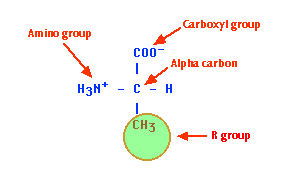alanine

Alanine, also known as 2-aminopropanoic acid, is one of the 20 amino acids used to synthesize proteins in terrestrial living organisms. It has the structural formula CH3C(NH2)COOH. As shown in the diagram, its alpha carbon atom is bonded to a carboxyl group (COO-), an amino group (NH3+), a methyl group (CH3), and a hydrogen atom. It exists as two distinct enantiomers, l-alanine and d-alanine, the former of which is used in protein synthesis. It is derived, for example, from silk.
Alanine is a nonessential amino, which means that it can be manufactured in the human body. Good dietary sources of alanine include meat, seafood, dairy products, eggs, corn, legumes, whole grains, beans, nuts, soy, brown rice, and bran.
Alanine aminopeptidase (AAP) is an enzyme used as a biomarker to detect damage to the kidneys, and that may be used to help diagnose certain kidney disorders. It is found at high levels in the urine when there are kidney problems.
Alanine transferase (also called serum glutamate pyruvate transaminase or SGPT) is an enzyme found in the liver and other tissues. A high level of alanine transferase released into the blood may be a sign of liver damage, cancer, or other diseases.


